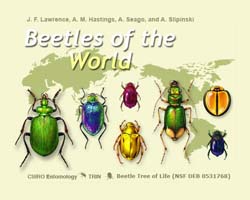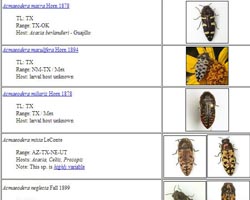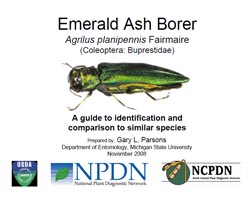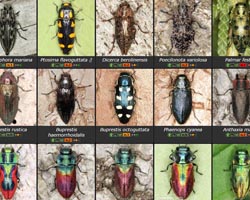Wood Boring Beetle Resource
Family Tool Search
Use the select menu to the left to view tools for a specific family or all families of wood boring beetles.
Beetles of the World
- Beetles (order Coleoptera) are the most diverse and species-rich group of animals in the world. This fully-illustrated key allows users to identify adult beetles to the level of family, subfamily, and often to genus.
- Taxonomic scope: Anobiidae, Bostrichidae, Brentidae, Buprestidae, Cerambycidae, Curculionidae , Lymexilidae , Oedemeridae , Zopheridae
- Geographic scope: World
- Authors: Lawrence, J.F., A.M. Hastings, A. Seago, and A. Slipinski
- Release date: 2010
Wood Boring Beetle Families of the World
- Wood Boring Beetle Families delimits family-level taxa (both adults and larvae) of Coleoptera known to be wood borer.
- Taxonomic scope: Anobiidae, Bostrichidae, Brentidae, Buprestidae, Cerambycidae, Curculionidae , Lymexilidae , Oedemeridae , Zopheridae
- Geographic scope: World
- Authors: Cline, A.R., M.A. Ivie, C.L. Bellamy, and J. Scher
- Release date: 2009
Buprestidae of Texas with Notes on Texas Types
- A photographic catalog of the metallic wood boring beetles of Texas.
- Taxonomic scope: Buprestidae
- Geographic scope: Nearctic
- Authors: Quinn, M.
- Release date: 2012
Discriminating Agrilus sulcicollis Lacordaire from Agrilus cyanescens Ratzeburg
- Agrilus sulcicollis Lacordaire is a medium sized exotic buprestid beetle first collected in Southeast Michigan in 2003. Native to Europe, A. sulcicollis oviposits in limbs and branches of oaks. Its similarity to other common Agrilus found in Michigan delayed the discovery for several years.
- Taxonomic scope: Buprestidae
- Geographic scope: Nearctic, Palearctic
- Authors: Zablotny, J.E.
- Release date: 2008
Agrilus planipennis Fairmaire Screening Aid
- Members of the genus Agrilus are challenging to identify due to structural coloration and subtle morphological differences between species. Furthermore, the presence of newly discovered exotic Agrilus species in the Midwest and Ontario complicates identification issues and demands a renewed interest in applied taxonomy of Agrilus beetles.
- Taxonomic scope: Buprestidae
- Geographic scope: Nearctic, Palearctic
- Authors: Zablotny, J.E.
- Release date: 2008
Emerald Ash Borer Agrilus planipennis Fairmaire (Coleoptera: Buprestidae) A guide to identification and comparison to similar species
- The adult stage of the Emerald Ash Borer (EAB) is fairly distinctive and usually easy to tell apart from most similarly colored and shaped buprestids and other insects by a trained taxonomist. However, many researchers and field workers currently sampling for EAB are not trained taxonomists, and might confuse some other similarly shaped or colored insects with EAB. The species included in this guide were chosen because of their relative commonness, similarity in size, shape and/or coloration to the EAB, and because specimens were available for photography in the A.J. Cook Arthropod Research Collection, at Michigan State University. Additional species, not included here, may be present in other parts of North America that could also potentially be confused with the EAB.
- Taxonomic scope: Buprestidae
- Geographic scope: Nearctic, Palearctic
- Authors: Parsons, G.L.
- Release date: 2008
Wood Boring Beetles
- Besides bark beetles, two other common families of beetles use woody plants to rear their offspring. The Buprestidae have one common name for the adult - metallic wood borer - and a second for the larvae - flat-headed wood borers. Similarly, adult Cerambycidae are generally known as long-horned beetles, while larvae are called round-headed wood borers. Some species in both families prefer conifers as hosts while others use only broadleaf trees. Many species attack live but usually stressed trees, while others prefer recently dead hosts.
- Taxonomic scope: Buprestidae, Cerambycidae
- Geographic scope: Neotropic
- Authors: Sutherland, Carol A.
- Release date: 2006
Buprestidae: The beetle fauna of Germany
- The jewel beetles (Buprestidae) are a very large family of very small to large species with beautiful glossy iridescent colors. Worldwide some 15,000 species in 450 genera have been scientifically described. The major centre of distribution is the tropical region. In Germany only 100 species are known to occur. The beetles are markedly thermophilic. In Germany many species are only found in relatively warm areas like the Upper-Rhine valley, where they reach the northern border of their distribution range. Adults and larvae are herbivorous and often strictly associated with their host plant.
- Taxonomic scope: Buprestidae
- Geographic scope: Palearctic
- Authors: Benisch, C.
- Release date: 2007



